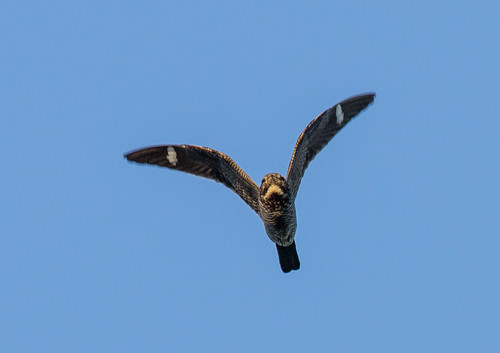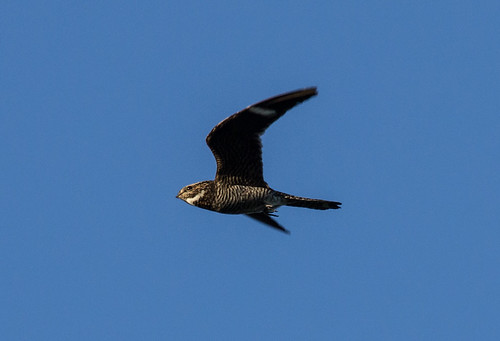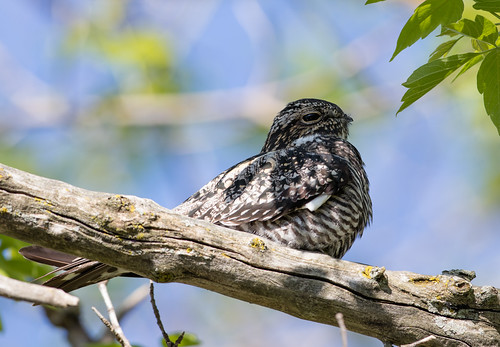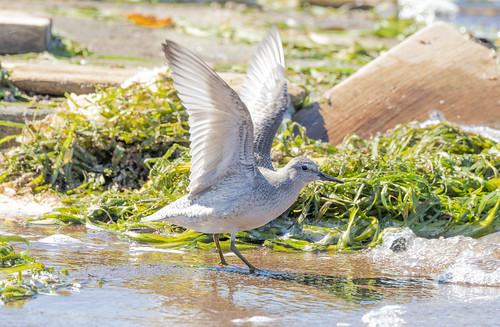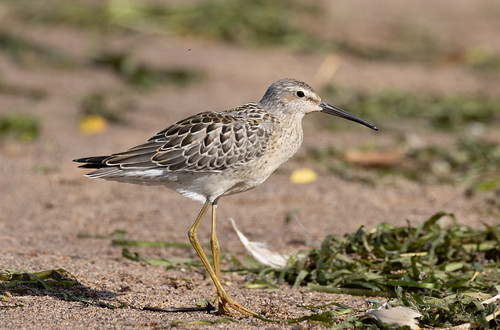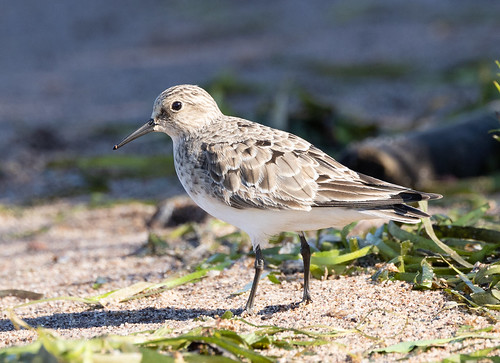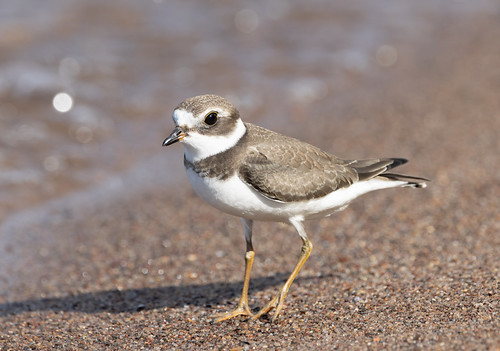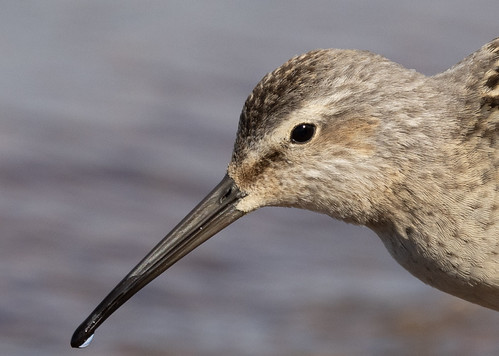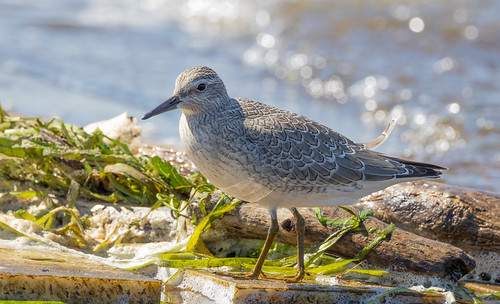The weeks immediately before and after Labor Day weekend are what I think of as the “Anything Can Happen” time of year. I can’t be outside long in my own yard or any wooded places without hearing chickadees and Red-breasted Nuthatches—that’s a constant. Cedar Waxwings eating berries, fly-catching from dead branches, and flying over in swirling flocks are another.
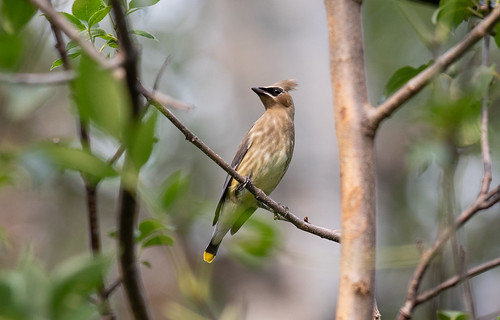 |
| Immature Cedar Waxwing |
And this is peak dragonfly time, as wonderful and exciting as it is bittersweet.
Dragonfly numbers have decreased enormously since I moved to Duluth. They’re still easy to see this time of year, but the numbers are nowhere near what they were. They're pigging out on other flying insects, as are nighthawks. Dozens and even hundreds of Common Nighthawks have been seen darting about over some fields in recent afternoons, and a couple of directed flights of over 2,000 have been observed.
In recent years, Steve Kolbe has been conducting a regular, standardized count at an excellent vantage point near the shore in Lester Park. Annual totals have spanned between 15,000 and 45,000. This is impressive and important work, but again just a fraction of what we used to be able to see. In the 80s and early 90s, I spent evenings counting thousands from my yard and when I walked my boys to late-afternoon/early-evening scout meetings half a mile away, though I was doing it for fun and not recording my numbers.
Local birders didn’t have the will or wherewithal to start doing standardized nighthawk counts back then, but on August 26, 1990, Mike Hendrickson, perched at the Lakewood Pumping Station, counted 43,690 nighthawks in 2 ½ hours, and the migration that day was heavy both before and after his tally. The huge nighthawk flights weren’t limited to one or two nights a year—unless it was raining, we were pretty much guaranteed to spot at least a dozen, and often hundreds or thousands, just about every night from mid-August through the first week of September.
Of course, even a single nighthawk is cause for celebration—this is one of my favorite birds of all for good reasons—so whenever I see even one, I’m as elated as cognizant of how much we’ve lost—the horrifying result of decades of pesticide use, development and damage to wetlands, and allowing craven oil corporations and people ignorant about science to prevent any proactive work to reduce our impact on climate change.
 |
| An adult male Evening Grosbeak sandwiched between two begging young. |
Evening Grosbeaks were another abundant constant this time of year. I started writing about their noticeable decline back in the early 90s, voicing my concerns in my first book, For the Birds: An Uncommon Guide, published in 1994. A few readers and listeners chided me for being alarmist because they were still seeing plenty in their rural yards. I’d so love to have been proven wrong. But since this IS that “Anything Can Happen” time of year, delightfully unexpected things still do happen. In August 2011, the morning after I brought Russ home after cancer surgery, we woke to the ethereal calls of Evening Grosbeaks. A flock of 16 birds, including at least 2 families, stuck around our yard for several weeks, right when we needed them most. Anything Can Happen.
On August 20, this year, for the first time on record, a Swallow-tailed Kite appeared at Hawk Ridge. It kited about snatching insects out of the sky for at least a half hour around 2 pm.
 |
| I didn't see the Swallow-tailed Kite in Duluth on August 20 (I took this photo in Florida), but did see one in Faribault, MN, in May 1999. |
I got a text alert about it while it was still there, and spent 45 minutes scanning the sky between my yard and the ridge, but never caught a glimpse. (The bird was eventually spotted from the Lake Aire Bottle Shop parking lot flying over the lake, and again in Wisconsin near the grain elevators, headed south where it belongs.) But while I was scanning, a flock of 6 American White Pelicans passed over. Yep—anything can happen.
Two days later, a Mississippi Kite flew over Hawk Ridge and was later seen over Mike Hendrickson’s yard in Smithville.
 |
| I've seen Mississippi Kites at Hawk Ridge a few times, but have never photographed them here. This photo is from a spring in Oklahoma. |
Mississippi Kites don't appear every year, but several times they have appeared at Hawk Ridge, always during the two weeks before or after Labor Day.
This week, we had some surprising shorebird visitors on Park Point. Two very cooperative Red Knots—a dangerously declining species—spent at least three days on the little bayside beach at the entrance of the Sky Harbor Airport, along with a Stilt Sandpiper, two Baird’s Sandpipers, and a Semipalmated Plover.
The birds somehow decided that birders don’t pose much of a threat. I sat there for over an hour on both Tuesday and Wednesday. The birds looked my way when I got there, but almost immediately resumed whatever they were doing. As other birders arrived, the shorebirds didn’t seem fazed at all. At one point when I was all alone, the Stilt Sandpiper and Red Knot started snoozing about 30 feet from me.
A few minutes later, the whole little flock started moseying down the beach directly toward me, and then right in front of me, just 6 or 7 feet away, giving me lots of satisfying full-frame photos in perfect light, as well as one of the most magical moments of my birding life.
There have been sightings of other rarities, such as Buff-breasted Sandpipers and a Smith's Longspur, in town in the past week. Plenty of migrants, including rarities here and there, will be passing through for the next month. A lot of people wait to look for them until what is considered the "best" time to go to Hawk Ridge, the second or third week of September. But that’s too late to see the best of the early migrants. Labor Day Weekend is the peak of my "Anything Can Happen" time. Get out there and enjoy some unexpected delights!
